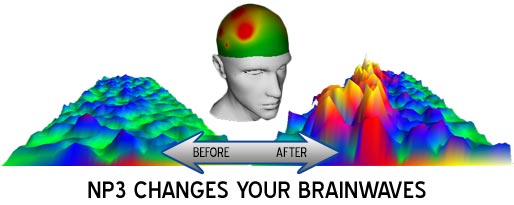All Business Tutorials>Hypnosis & NLP
Neuro programmer 3
Neuro programmer 3
| How does NP3 change your brainwaves?NP3 can change brain wave activity, which is directly connected to your state of mind, using brainwave entrainment (pronounced: “ehn – TRAIN – mint”) – the process of externally presenting brainwave frequencies to the brain, allowing it to synchronize to those frequencies.1 2 3Snap your fingers. That sound just created an electronic reaction in your brain. If that snapping sound was constant and consistent at the same frequency associated with a calm state of mind, your brain waves would continue to react and would start to synchronize with that rhythm. Over time, you would actually begin to feel more relaxed.4 |
It’s surprising science, but thanks to modern equipment it’s easy to prove that this works because we can watch it happening on an EEG. And over 80 years of scientific investigation have revealed many useful applications for this method, which are being widely used today.5 Neuro-Programmer 3 takes advantage of the latest research in this field to deliver the most effective neural stimulation experience.

|
Take control of your mind
Imagine if you could rewire your brain to connect situations and mental states in a way that you choose. We’re not saying the process is instant, but NP3 makes it possible. Research has revealed the brain wave states where applied psychological techniques such as suggestions, affirmations or hypnotic scripts can be most effective.6 Using brainwave entrainment, NP3 can guide your mind to a receptive mental state, at which point the program uses your choice of those techniques. When combined with the right neural stimulation, these techniques can bypass mental and emotional barriers that would normally make the mind resistant to change, making it much more likely that affirmations or suggestions will be effective.7 8 This is what we call self-programming, and using it can allow you to you control your own mind and life in a unique and powerful way. |
“…these techniques can bypass mental and emotional barriers that would normally make the mind resistant to change”
|
The many uses of NP3We’re constantly scouring the scientific literature and consulting with leading experts and researchers in the field to ensure that NP3 is always based on the latest knowledge. We draw directly from the protocols used in peer-reviewed research to successfully and significantly:
Visit the benefits section to discover all of the applications for this software, read much more information about how these benefits can be attained, and learn about the research and studies supporting the sessions we’ve created. |
– Bruce Ehrlich, Psychologist, Author, President of Mind Media, Inc. |
Inspired and informed by the best practices and research in the fields of psychology, neurology, and audio-visual stimulation studies, Neuro-Programmer 3 is a software application with unlimited potential and broad capabilities. Although it is incredibly simple to use, it’s also one of the most effective tools for positive mental change that you’ll ever find.
1. Adrian E, Mathews B. The Berger Rhythm: potential changes from the occipital lobes in man. Brain. 1934;57(4):355-384.
2. Dempsey E, Morison R. The interaction of certain spontaneous and induced cortical potentials. Am J Physiol. 1941;135:301-308.
3. Chatrian GE, Petersen MC, Lazarte JA. Responses to clicks from the human brain: some depth electrographic observations. Electroencephalogr Clin Neurophysiol. 1960 May;12:479-489
4. Padmanabhan R, Hildreth AJ, Laws D. A prospective, randomised, controlled study examining binaural beat audio and pre-operative anxiety in patients undergoing general anaesthesia for day case surgery. Anaesthesia. 2005;60(9):874-877
5. Huang, Tina L., and Christine Charyton. A comprehensive review of the psychological effects of brainwave entrainment. Altern Ther Health Med 14.5 (2008): 38-50.
6. Sabourin, M. E., Cutcomb, S. D., Crawford, H. J., & Pribram, K. (1990). EEG correlates of hypnotic susceptibility and hypnotic trance: spectral analysis and coherence. International Journal of Psychophysiology, 10(2), 125-142.
7. Kroger, W. S., & Schneider, S. A. (1959). An electronic aid for hypnotic induction: A preliminary report. International Journal of Clinical and Experimental Hypnosis, 7(2), 93-98.
8. Wickramasekera I, I. E. (1977). On attempts to modify hypnotic susceptibility: Some psychophysiological procedures and promising directions. Annals of the New York Academy of Sciences, 296, 143-153
9. Ossebaard HC. Stress reduction by technology? An experimental study into the effects of brainmachines on burnout and state anxiety. Appl Psychophysiol Biofeedback. 2000;25(2):93-101.
10. Le Scouarnec RP, Poirier RM, Owens JE, Gauthier J, Taylor AG, Foresman PA. Use of binaural beat tapes for treatment of anxiety: a pilot study of tape preference and outcomes. Altern Ther Health Med. 2001;7(1):58-63.
11. Patrick GJ. Improved neuronal regulation in ADHD: An application of 15 sessions of photic-driven EEG neurotherapy. J Neurother. 1996;1(4):27-36.
12. Siever, D. Applying Audio-Visual Entrainment Technology for Attention and Learning. Biofeedback Magazine. 2003; 31(4)
13. Budzynski T, Jordy J, Budzynski HK, Tang H, Claypoole K. Academic performance enhancement with photic stimulation and EDR feedback. J Neurother. 1999;3(3-4):11-21
14. Olmstead R. Use of auditory and visual stimulation to improve cognitive abilities in learning-disabled children. J Neurother. 2005;9(2):49-61
15. Howard CE, Graham LE, 2nd, Wycoff SJ. A comparison of methods for reducing stress among dental students. J Dent Educ. 1986;50(9):542-544
16. Siever, D. (2002) “The Rediscovery of Audio-Visual Entrainment Technology.
17. Siever, D. (2004). The application of audio-visual entrainment for the treatment of seasonal affective disorder. Biofeedback, 32 (3), 32-35.
18. Kumano, H., Horie, H., Shidara, T., Kuboki, T., Suematsu, H., & Yasushi, M. (1996). Treatment of a depressive disorder patient with EEG-driven photic stimulation. Biofeedback and self-regulation, 21(4), 323-334.
***If link dead, please leave a message, we will update immediately***[/color][/b][/center] [center][b]Rapidgator[/b] [code] http://filetut.com/rt9s49dbyx5t/NeuroProgrammer.3.2.6.Portable.rar.html
[/center] [subscribe2]





 “This is the most powerful self-programming software that I have come across during my 15 years of evaluating mindware programs.”
“This is the most powerful self-programming software that I have come across during my 15 years of evaluating mindware programs.”



